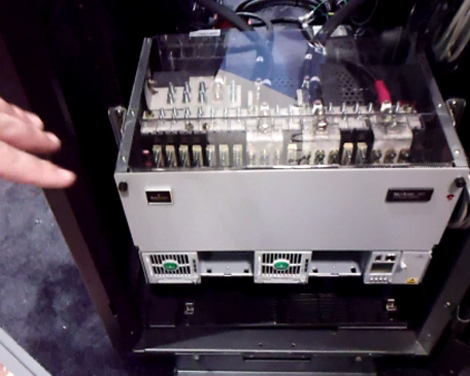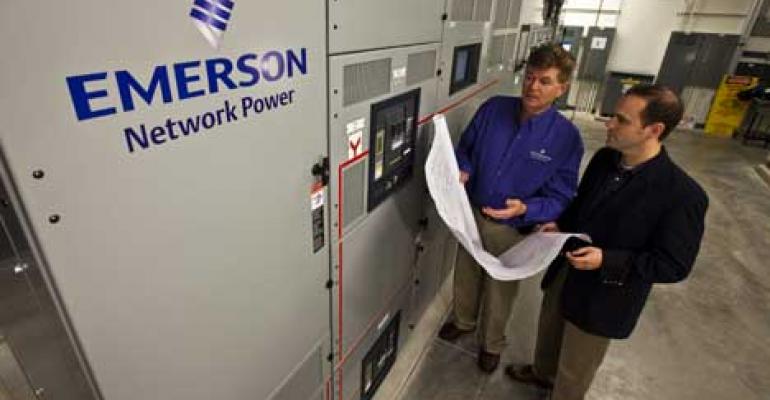
At January's Open Compute Summit, the Emerson Network Power team displayed rack solution that can support densities of up to 45KW per rack, just one example of how the company is adapting to pursue the hyperscale market. (Photo: Colleen Miller)
Cooling isn't just about CRAC units anymore. For many years, data center cooling involved placing CRAC (computer room air conditioner) units at the perimeter of a data hall to feed cool air into a sub-floor plenum. But managing a data center environment has now become more complex and sophisticated, involving higher power densities and warmer temperatures. These advances have shifted cooling equipment to the row and rack level, as well as a wide range of containment strategies, and software to tie it all together.
That's why Emerson Network Power is adopting a new name for its Liebert precision cooling operation, which will now be known as the Thermal Management business. The new business will have annual revenues of approximately $800 million. While it may seem like a euphemism, Emerson says the updated moniker reflects a new way of thinking about cooling challenges.
“The data center is an active, always-changing ecosystem where IT needs, geographic location and external weather conditions are connected, and changes in any one area have broad implications,” said John Schneider, who will lead the new Thermal Management business as vice president and general manager. “We are delivering the next generation of data center cooling, with innovative services, software and hardware integrated and optimized to reliably, efficiently and cost-effectively control and manage heat.”
Focus on Advanced Environments
So what does this "next generation" approach include? It likely means a bigger focus on specialized environments for hyperscale data centers, high performance computing systems, and environments customized to process "Big Data." An example could be seen at the recent Open Compute Summit, when a team from Emerson Network Power demonstrated a rack that can support power densities of up to 45KW per rack, integrating power distribution and back-up into the Open Rack specification. Emerson was the first of the major power and cooling vendors to participate in the Open Compute initiative, which is oriented toward hyperscale data center operators such as Facebook.
Schneider said the development of Emerson's Thermal Management unit was influenced by expanded temperature guidelines from the American Society of Heating, Refrigerating and Air-Conditioning Engineers (ASHRAE). Raising the baseline temperature inside the data center can save money by reducing the amount of energy used for air conditioning, and can allow expanded use of free cooling (the use of fresh air instead of air conditioners to cool servers).
But pushing the boundaries on temperature requires more granular monitoring and management of the data center environment, so any thermal problems can be quickly detected and addressed. Emerson says its Thermal Management unit will offer air-side and water-side free cooling solutions and innovative pumped-refrigerant economizers in addition to state-of-the-art controls and wireless sensors.
Building Upon the Liebert Legacy
“For 48 years, the Liebert brand has been synonymous with IT cooling and innovation, and today’s announcement represents another significant evolution within that space,” said Scott Barbour, executive vice president, Emerson, and business leader, Emerson Network Power (Systems). “The basic need to manage heat is not changing. There are now more ways to do that, and this expansion of what began as our precision cooling business reflects the entire spectrum of possibilities.”
Introduced in 1965, Liebert CRAC systems were the first self-contained IT cooling units capable of maintaining air temperature, humidity and air quality within precision tolerances. Today’s data center infrastructure systems use networks of wireline and wireless sensors to monitor equipment performance and environmental conditions and are better equipped to act on that data. These capabilities were not available in the past and, even today, the additional intelligence often is lost in floods of data.
“What we’re doing with our approach to thermal management is helping our customers analyze, understand and act on that data to realize more efficient, more sophisticated real-time environmental control,” Schneider said. That control is realized through innovative hardware, software and services that include everything from more intelligent and versatile cooling technologies to data center infrastructure management systems to remote service delivery programs.





